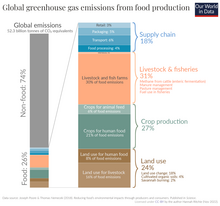
The amount of greenhouse gas emissions from agriculture is significant: The agriculture, forestry and land use sectors contribute between 13% and 21% of global greenhouse gas emissions.[2] Emissions come from direct greenhouse gas emissions (for example from rice production and livestock farming).[3] And from indirect emissions. With regards to direct emissions, nitrous oxide and methane makeup over half of total greenhouse gas emissions from agriculture.[4] Indirect emissions on the other hand come from the conversion of non-agricultural land such as forests into agricultural land.[5][6] Furthermore, there is also fossil fuel consumption for transport and fertilizer production. For example, the manufacture and use of nitrogen fertilizer contributes around 5% of all global greenhouse gas emissions.[7] Livestock farming is a major source of greenhouse gas emissions.[8] At the same time, livestock farming is affected by climate change.
Farm animals' digestive systems can be put into two categories: monogastric and ruminant. Ruminant cattle for beef and dairy rank high in greenhouse gas emissions. In comparison, monogastric, or pigs and poultry-related foods, are lower. The consumption of the monogastric types may yield less emissions. Monogastric animals have a higher feed-conversion efficiency and also do not produce as much methane.[9] Non-ruminant livestock, such as poultry, emit far fewer greenhouse gases.[10]
There are many strategies to reduce greenhouse gas emissions from agriculture (this is one of the goals of climate-smart agriculture). Mitigation measures in the food system can be divided into four categories. These are demand-side changes, ecosystem protections, mitigation on farms, and mitigation in supply chains. On the demand side, limiting food waste is an effective way to reduce food emissions. Changes to a diet less reliant on animal products such as plant-based diets are also effective.[11]: XXV This could include milk substitutes and meat alternatives. Several methods are also under investigation to reduce the greenhouse gas emissions from livestock farming. These include genetic selection,[12][13] introduction of methanotrophic bacteria into the rumen,[14][15] vaccines, feeds,[16] diet modification and grazing management.[17][18][19]
- ^ "Food production is responsible for one-quarter of the world's greenhouse gas emissions". Our World in Data. Retrieved 20 July 2023.
- ^ Nabuurs, G-J.; Mrabet, R.; Abu Hatab, A.; Bustamante, M.; et al. "Chapter 7: Agriculture, Forestry and Other Land Uses (AFOLU)" (PDF). Climate Change 2022: Mitigation of Climate Change. p. 750. doi:10.1017/9781009157926.009..
- ^ Steinfeld H, Gerber P, Wassenaar T, Castel V, Rosales M, de Haan C (2006). Livestock's long shadow: environmental issues and options (PDF). Food and Agriculture Organization of the UN. ISBN 978-92-5-105571-7. Archived from the original (PDF) on 25 June 2008.
- ^ FAO (2020). Emissions due to agriculture. Global, regional and country trends 2000–2018 (PDF) (Report). FAOSTAT Analytical Brief Series. Vol. 18. Rome. p. 2. ISSN 2709-0078.
- ^ Section 4.2: Agriculture's current contribution to greenhouse gas emissions, in: HLPE (June 2012). Food security and climate change. A report by the High Level Panel of Experts (HLPE) on Food Security and Nutrition of the Committee on World Food Security. Rome, Italy: Food and Agriculture Organization of the United Nations. pp. 67–69. Archived from the original on 12 December 2014.
- ^ Sarkodie, Samuel A.; Ntiamoah, Evans B.; Li, Dongmei (2019). "Panel heterogeneous distribution analysis of trade and modernized agriculture on CO2 emissions: The role of renewable and fossil fuel energy consumption". Natural Resources Forum. 43 (3): 135–153. doi:10.1111/1477-8947.12183. ISSN 1477-8947.
- ^ "Carbon emissions from fertilizers could be reduced by as much as 80% by 2050". Science Daily. University of Cambridge. Retrieved 17 February 2023.
- ^ "How livestock farming affects the environment". www.downtoearth.org.in. Retrieved 10 February 2022.
- ^ Friel, Sharon; Dangour, Alan D.; Garnett, Tara; et al. (2009). "Public health benefits of strategies to reduce greenhouse-gas emissions: food and agriculture". The Lancet. 374 (9706): 2016–2025. doi:10.1016/S0140-6736(09)61753-0. PMID 19942280. S2CID 6318195.
- ^ "The carbon footprint of foods: are differences explained by the impacts of methane?". Our World in Data. Retrieved 14 April 2023.
- ^ United Nations Environment Programme (2022). Emissions Gap Report 2022: The Closing Window — Climate crisis calls for rapid transformation of societies. Nairobi.
- ^ "Bovine Genomics | Genome Canada". www.genomecanada.ca. Archived from the original on 10 August 2019. Retrieved 2 August 2019.
- ^ Airhart, Ellen. "Canada Is Using Genetics to Make Cows Less Gassy". Wired – via www.wired.com.
- ^ "The use of direct-fed microbials for mitigation of ruminant methane emissions: a review".
- ^ Parmar, N.R.; Nirmal Kumar, J.I.; Joshi, C.G. (2015). "Exploring diet-dependent shifts in methanogen and methanotroph diversity in the rumen of Mehsani buffalo by a metagenomics approach". Frontiers in Life Science. 8 (4): 371–378. doi:10.1080/21553769.2015.1063550. S2CID 89217740.
- ^ "Kowbucha, seaweed, vaccines: the race to reduce cows' methane emissions". The Guardian. 30 September 2021. Retrieved 1 December 2021.
- ^ Boadi, D (2004). "Mitigation strategies to reduce enteric methane emissions from dairy cows: Update review". Can. J. Anim. Sci. 84 (3): 319–335. doi:10.4141/a03-109.
- ^ Martin, C. et al. 2010. Methane mitigation in ruminants: from microbe to the farm scale. Animal 4 : pp 351-365.
- ^ Eckard, R. J.; et al. (2010). "Options for the abatement of methane and nitrous oxide from ruminant production: A review". Livestock Science. 130 (1–3): 47–56. doi:10.1016/j.livsci.2010.02.010.